Quick facts about thyroid cancer
In 2021, it’s estimated that 3,830 Australians were diagnosed with thyroid cancer. This makes thyroid cancer the 9th most commonly diagnosed cancer in Australia
Thyroid cancer is more common in women than in men. In 2021, women were two and half times more likely to develop thyroid cancer
The five-year survival rate for thyroid cancer is 97%
Thyroid cancer primarily develops from two types of cells: follicular cells (which produce and store the hormones T3 and T4 and the protein thyroglobulin) and parafollicular cells (which produce the hormone calcitonin and help control calcium levels in the body)
Types of thyroid cancer
Thyroid cancer is classified based on the appearance of its cancerous cells. It is possible to have multiple types of thyroid cancer, however this is rare. The types of thyroid cancer include:
-
Papillary thyroid cancer
Papillary thyroid cancer is the most common type of thyroid cancer, making up 70-80% of all cases. It develops from the follicular cells and tends to grow slowly to areas such as surrounding lymph nodes.
-
Follicular thyroid cancer
Follicular thyroid cancer makes up 15-25% of thyroid cancer cases and develops from follicular cells. Although it is unlikely to spread to the lymph nodes, it can spread to other parts of the body. Hürthle cell carcinoma is a rare and more aggressive type of follicular thyroid cancer.
-
Medullary thyroid cancer
Medullary thyroid cancer develops from the parafollicular cells (C-cells) and makes up 4% of all thyroid cancer cases. It can be passed down through families (hereditary thyroid cancer).
-
Anaplastic thyroid cancer
Anaplastic thyroid cancer is a rare and fast-growing type of thyroid cancer, which develops from papillary or follicular thyroid cancer.
Signs and symptoms of thyroid cancer
As signs and symptoms for thyroid cancer can be similar to other common conditions, it’s important to see your GP or healthcare professional if you experience any of the symptoms below. Discussing anything concerning as soon as possible can help give you peace of mind and offer the best chance of successful treatment if you receive a thyroid cancer diagnosis.
Symptoms for thyroid cancer tend to develop slowly and may include:

Lump in the neck or throat that grows over time

Pain in the neck or throat

Difficulty swallowing or breathing

Hoarseness or changes in your voice

Swollen glands (lymph nodes) in your neck
Stages of thyroid cancer
The TNM system is used to stage thyroid cancer and define what your cancer looks like. The TNM stands for:
Tumour – Describes the size of the tumour and if it has affected other tissue, such as the neck
Node – Is a measure of whether lymph nodes have been affected
Metastasis – The degree to which the cancer has spread to other organs of the body, such as the lungs or bones.
The TNM information, along with other tests, helps determine the stage of your thyroid cancer using the guidelines below:
Papillary and follicular thyroid cancer
Only Stage I and Stage II apply to those under 55 years of age.
-
Stage I
The cancer is no larger than 4 cm and confined to the thyroid. For those under 55, the cancer may be any size and might or might not have spread to nearby lymph nodes.
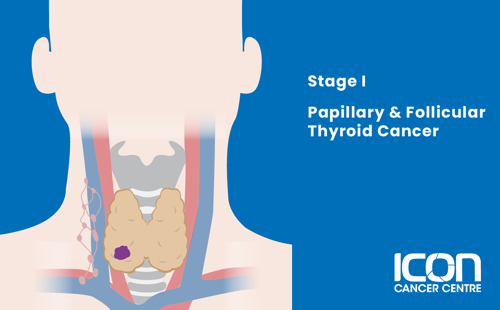
-
Stage II
The cancer is no larger than 4 cm across and confined to the thyroid, but has spread to nearby lymph nodes. For those under 55, the cancer may be any size and has spread to other areas of the body such as distant lymph nodes, internal organs or bone.
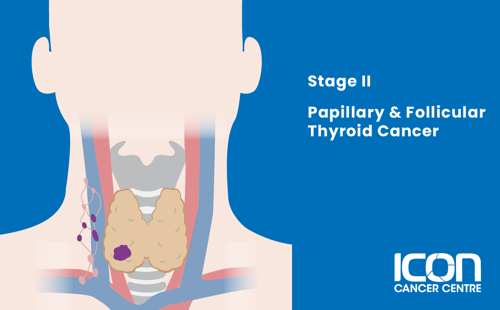
-
Stage III
The cancer may be any size and has spread to nearby tissue such as the larynx, trachea or oesophagus. It might or might not have spread to nearby lymph nodes.
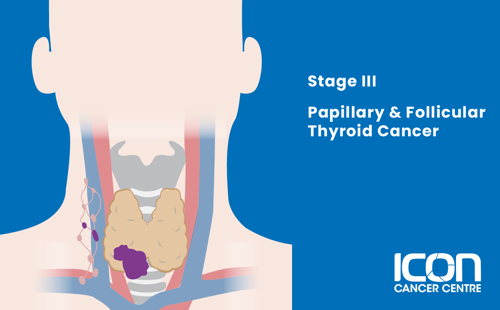
-
Stage IVA
The cancer may be any size and has spread extensively beyond the thyroid toward the spine or into nearby large blood vessels. It might or might not have spread to nearby lymph nodes.
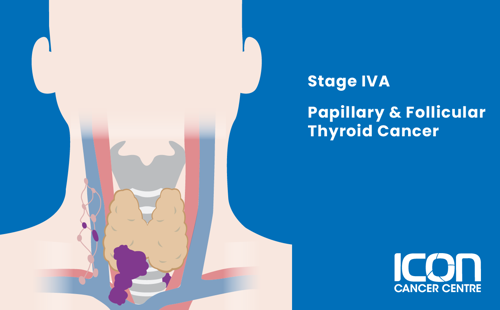
-
Stage IVB
The cancer is any size and might or might not have spread to nearby lymph nodes, but has spread to distant areas of the body such as lymph nodes, internal organs or bones.
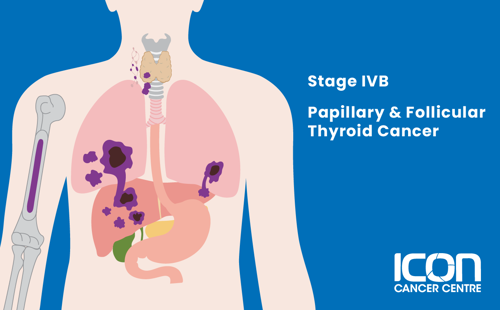
Anaplastic thyroid cancer
All anaplastic thyroid cancers are considered Stage IV.
-
Stage IVA
The cancer is any size and confined to the thyroid.
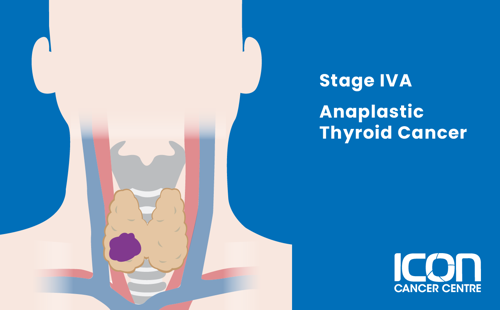
-
Stage IVB
The cancer is any size and confined to the thyroid, but has spread to nearby lymph nodes. Alternatively, the cancer is any size and has grown into the strap muscles around the thyroid, but might or might not have spread to nearby lymph nodes.
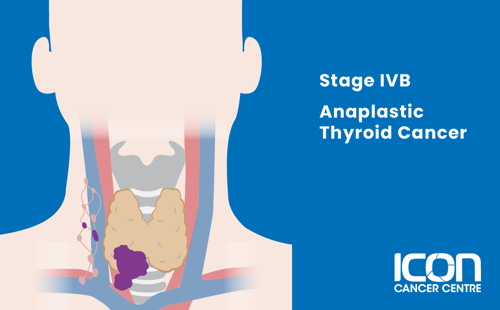
-
Stage IVC
The cancer is any size and might or not have spread to nearby lymph nodes, but has spread to distant areas of the body such as lymph nodes, internal organs or bone.
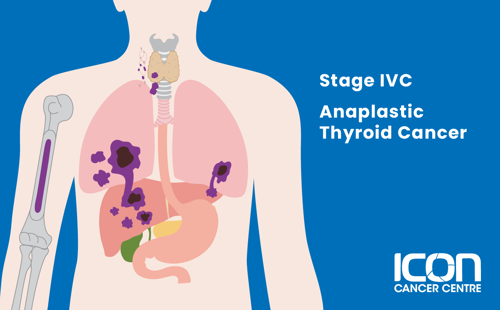
Medullary thyroid cancer
-
Stage I
The cancer is no larger than 2 cm and confined to the thyroid.
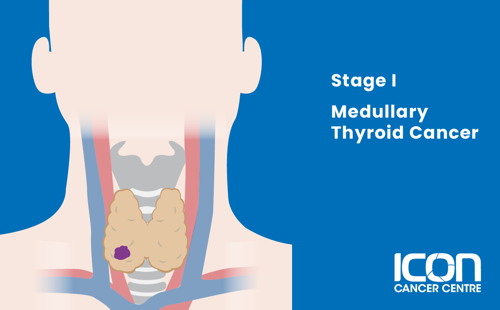
-
Stage II
The cancer is no larger than 4 cm across and confined to the thyroid. Alternatively, the cancer is larger than 4 cm and confined to the thyroid, or any size and growing outside of the thyroid but not involving nearby structures.
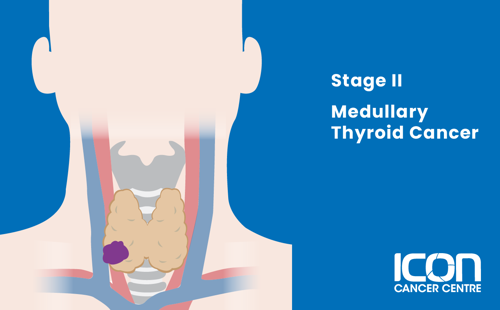
-
Stage III
The cancer is any size and may be growing outside of the thyroid but not involving nearby structures. It has spread to lymph nodes in the neck.
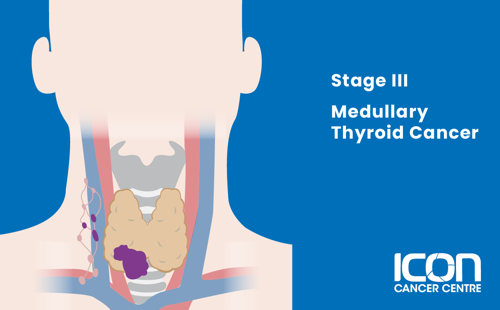
-
Stage IVA
The cancer is any size and has grown into nearby tissues in the neck, such as the larynx, trachea or oesophagus. It might or might not have spread to nearby lymph nodes. Alternatively, the cancer is any size and might be growing outside of the thyroid, but has spread to certain lymph nodes in the neck.
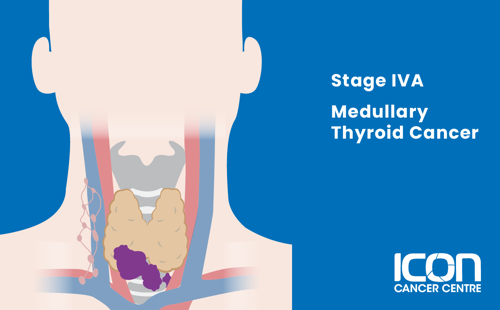
-
Stage IVB
The cancer is any size and has grown toward the spine or into nearby large blood vessels, but might or might not have spread to nearby lymph nodes.
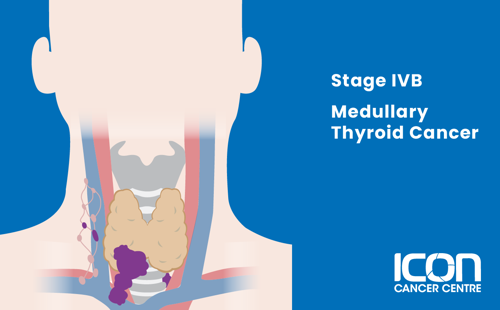
-
Stage IVC
The cancer is any size and might have grown into nearby structures or lymph nodes, but has spread to distant areas of the body such as the liver, lung, bone or brain.
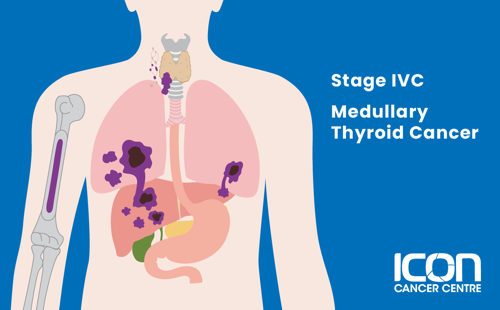
Treatment for thyroid cancer
There are many different types of treatment for thyroid cancer. Your treatment will depend on you and your cancer.




